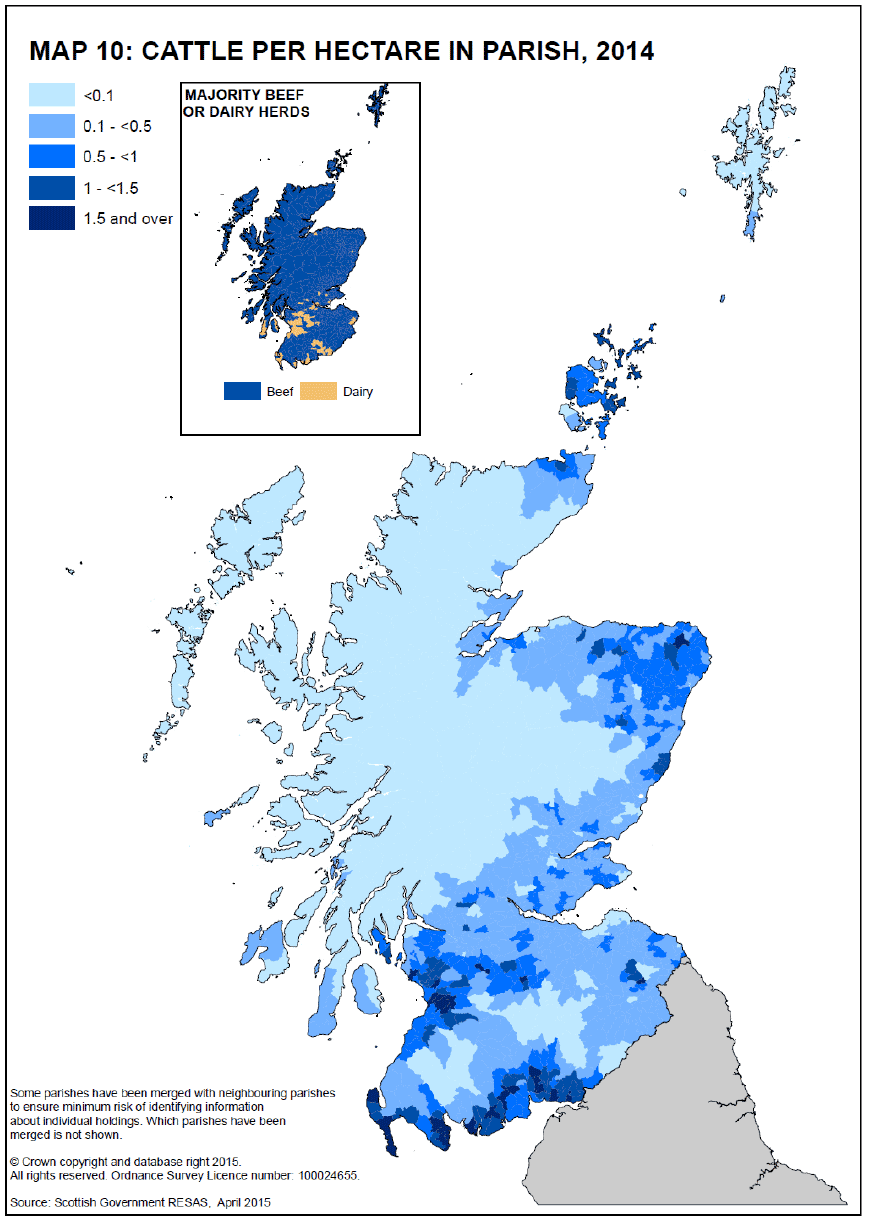Economic Report on Scottish Agriculture 2015
Economic Report on Scottish Agriculture 2015 presenting an overall picture of Scottish agriculture using data from the various agricultural surveys that RESAS manage.
5.2 Cattle
Chart 5.4 shows that the number of cattle in Scotland has been steadily falling since an historical peak of 2.7 million in 1974. Prior to that it had risen slowly from a constant 1.2 million in the first three decades of the 20th century. Over half of that increase had been lost by 2014.
Chart 5.4: Number of cattle in Scotland, 1883-2014
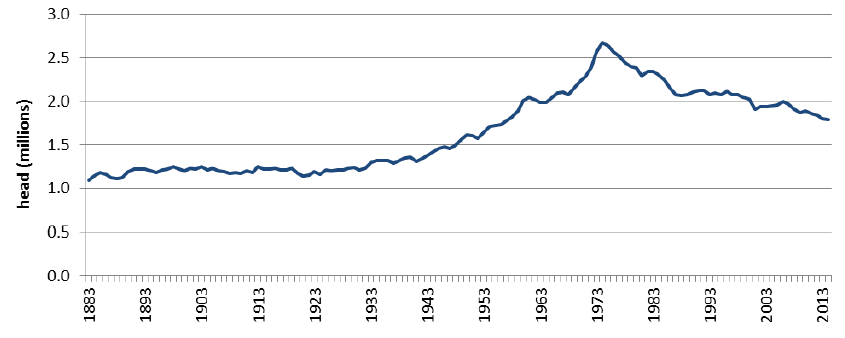
5.2.1 Distribution of dairy and beef herds (Table C10(i), C10(ii))
In 2014 there were 1.79 million cattle in Scotland. The greatest number of cattle were located in Dumfries & Galloway (429,000 cattle or 24 per cent of the total) while 359,000 were in Grampian (20 per cent). Ayrshire (191,000 or 11 per cent), the Clyde Valley (139,000 or eight per cent), Scottish Borders (131,000 or seven per cent) and Highlands (127,000 or seven per cent) also had relatively high numbers of cattle.
Chart 5.5: Distribution of cattle by sub-region, June 2014
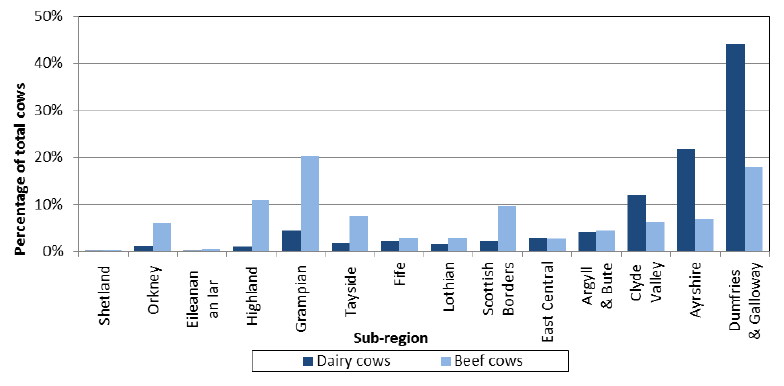
Dairy cows[10] totalled 170,000 in June 2014, of which just over three quarters were located across the south western sub-regions of Dumfries & Galloway (74,900 or 44 per cent), Ayrshire (36,900 or 22 per cent) and the Clyde Valley (20,400 or 12 percent). In contrast, beef cows[11], which totalled 436,000, had a wider regional spread, with large numbers evident in more northerly sub-regions such as Grampian (88,700 or 20 per cent) and Highland (47,800 or 11 per cent) as well as Dumfries & Galloway (78,300 or 18 per cent) and the Scottish Borders (42,100 or ten per cent). Map 10 illustrates that the highest density of cattle are to be found in the south-west and north-east. In addition, the inset map shows that beef predominates over dairy in most areas apart from patches in the south west of Scotland.
5.2.2 Size of dairy and beef herds (Tables C11, C12)
Chart 5.6 shows that almost two-thirds (65 per cent) of dairy cows were in herd sizes of 150 or more, totalling 111,000. A further 35,500 (21 per cent) were in herd sizes of between 100 and 149, with the remaining 23,100 (14 per cent) in herd sizes less than 100. This illustrates the concentrated distribution of the dairy sector.
Chart 5.6: Dairy cows by region and herd-size group, June 2014
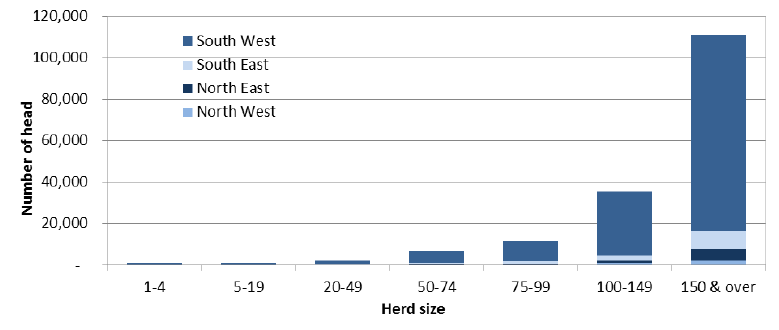
The distribution of beef cows is less skewed, as shown in chart 5.7. The largest proportion (30 per cent) of beef cows were in a herd size of 150 or more, totalling 129,000 cows. Whereas 65 per cent of dairy cows were held in holdings with herds of 150 cattle and over, a similar proportion (63 per cent) among beef cattle was accounted for by holdings with herds of 75 cattle and over.
Chart 5.7: Beef cows by region and herd-size group, June 2014
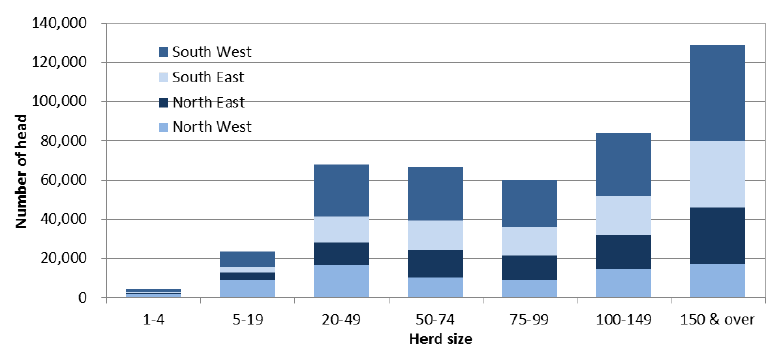
5.2.3 Income from cattle (Table A5)
Over the past decade the total output value of finished and store livestock, excluding related subsidies, has increased by £333 million (93 per cent) to £690 million in 2014 (chart 5.1). The value has increased each year with the exception of 2007 and 2014. Two of the largest increases occurred in 2008 (£88 million) and 2011 (£81 million). Output from cattle equates to about 23 per cent of total agricultural output.
Tables A5 and A6 provide the detail behind these livestock valuations including numbers of livestock, weight of meat production, average output prices and stock change valuations.
In 2014, the output value of store cattle and calves was £49.8 million, similar to levels in 2011, a decrease of £22 million from 2013 (31 per cent).
Total beef production in 2014 (including cull of older cattle) was at 169,000 tonnes, remaining fairly stable over the past ten years, with some higher levels in the intervening years (chart 5.2). Chart 5.8 shows that finished beef production increased slightly in 2014, halting a trend of small decreases each year since 2010.
Chart 5.8: Finished cattle production and average price, 2004-2014
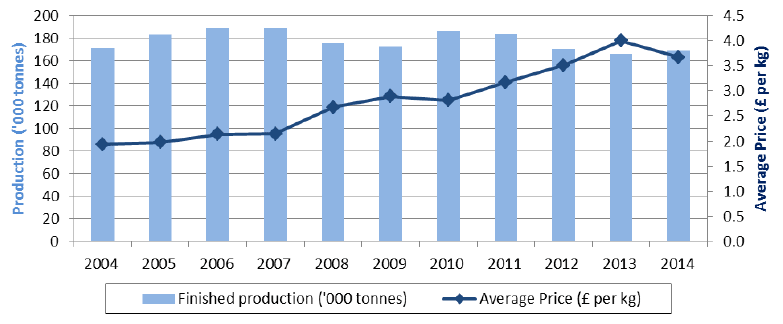
Clean finished cattle prices had risen in each year throughout the past ten years, except 2010, up from an average of £1.93 per kg in 2004 to £4.00 per kg in 2013, a rise of 107 per cent. This trend has been the key factor in the large increase in the output value of cattle. However there was an eight per cent fall in price in 2014 to £3.66 per kg.
Chart 5.9 Monthly cattle marts prices in 2009, 2013 and 2014
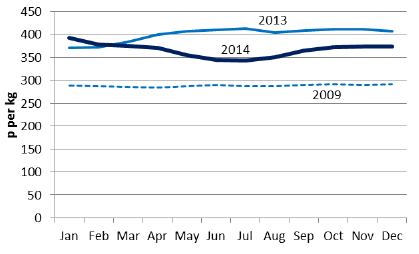
Prices fell in the first part of 2014, from 393p per kg in January to 343p per kg in July, with prices then rising from August ending the year at 374p per kg.
5.2.4 Specialist Cattle (LFA) FBI (Table B1)
Accounting for inflation, between 2009-10 and 2013-14 the average FBI of specialist cattle (LFA) farms decreased by around 49 per cent, to the lowest level in five years. This decrease was due to a rise in input costs, especially livestock-related and crop-related costs and a fall in subsidies.
In the last year input costs and output value for specialist cattle (LFA) farms have both increased, resulting in an overall decline in profits for 2013-14. The average value of grants and subsidies increased (up £400) to leave the FBI value of specialist cattle (LFA) farms at £25,000. The total average outputs, (including income from diversification and grants and subsidies) and inputs for specialist cattle (LFA) farms were £185,000 and £160,000 respectively. The largest portion of the input costs was due to feed and other inputs such as machinery, land and buildings.
Over the last five years, FBI without subsidies has been below zero, ranging from -£10,000 in 2009-10 to -£30,000 in 2013-14.
The average FBI/FTE for specialist cattle farms of £17,000 is roughly equivalent to an hourly wage for unpaid labour of £8.82, just under one and a half times the minimum agricultural wage in Scotland. Approximately 32 per cent of farms generated an FBI/FTE equivalent to at least twice the minimum agricultural wage per hour of unpaid labour. At the top end, five per cent generated between five and ten times the minimum agricultural wage, that is, between £33.40 and £68.90 per hour of unpaid labour and one per cent generated more. In contrast, 39 per cent of specialist cattle farms generated incomes equivalent to less than the minimum agricultural wage.
Trends in cost centres for specialist cattle (LFA) farms show an overall decrease in income from agricultural activities compared to 2012-13, costs remained steady for diversification, contracting, subsidies and agri-environmental activities.
The average net worth of specialist cattle (LFA) farms of all tenures was £1,058,000; from £365,000 for tenanted farms, to £1,207,000 for owner occupied farms and £1,208,000 for mixed tenure farms. The average debt ratio (liabilities: assets) was ten per cent for all tenures of specialist cattle (LFA) farms but ranged between ten per cent for owner-occupied and 13 per cent for tenanted farms.
Specialist Cattle Farms (LFA)
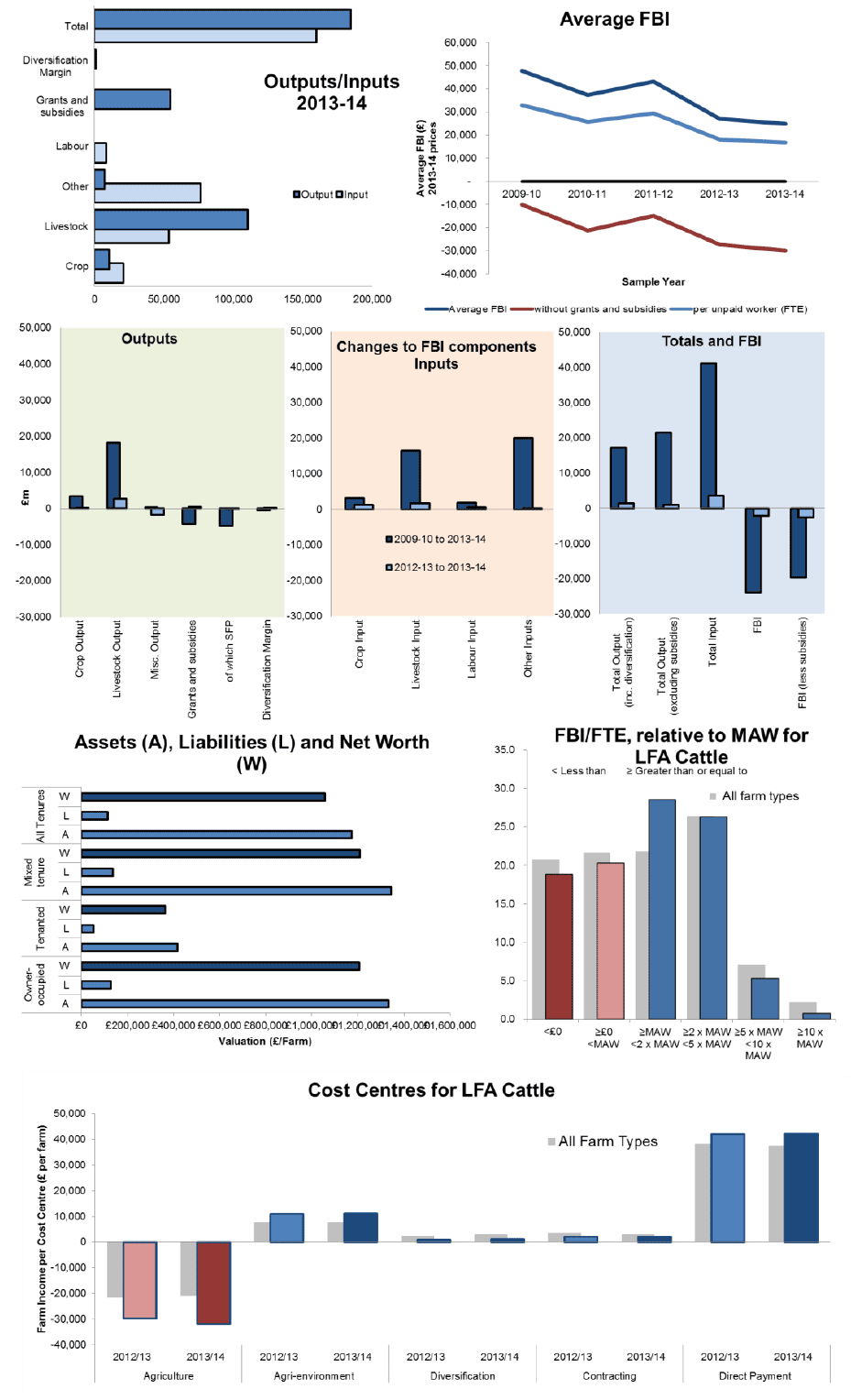
5.2.5 Income from milk and milk products (Table A6)
The production of milk and milk products accounted for an estimated £447 million of output in 2014, about 15 per cent of total farming output. The value of milk was equivalent to just over half the output from beef, and more than the value of meat from sheep, pigs and poultry put together. The value has increased by 73 per cent since 2004, with the most notable increases occurring in 2008 (25 per cent) and 2013 (16 per cent) with a further six per cent increase to 2014 (see chart 5.12).
Milk production has been fairly steady in the last ten years, with very little difference between 2013 production and the 2004 level, followed by a slight increase observed in 2014. After a settled period between 2004 and 2005 where prices and production remained stable, production fell by 60 million litres (just four per cent) between 2006 and 2009, but production is now at the highest level it has been over the decade.
Chart 5.10 Milk (including milk products) production and average price 2004 to 2014
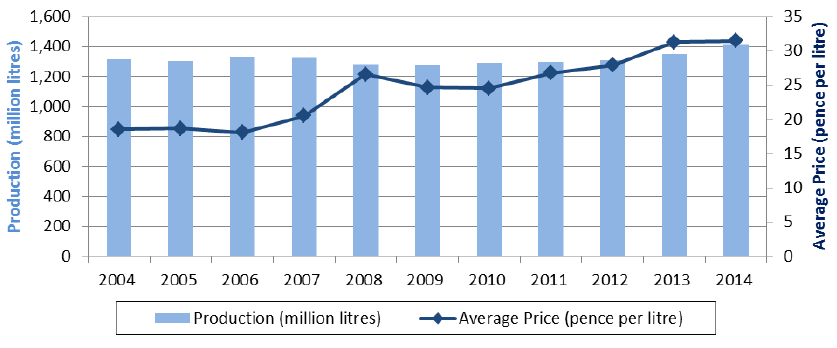
Chart 5.11 Monthly milk prices in 2009, 2013 and 2014
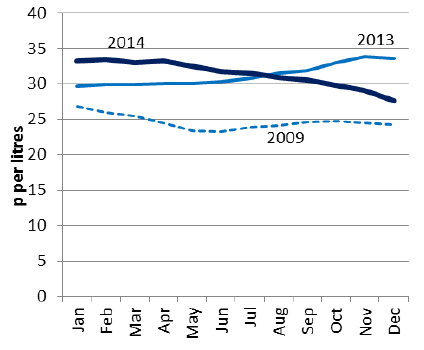
Chart 5.12 Output value of milk and milk products, 2004 to 2014
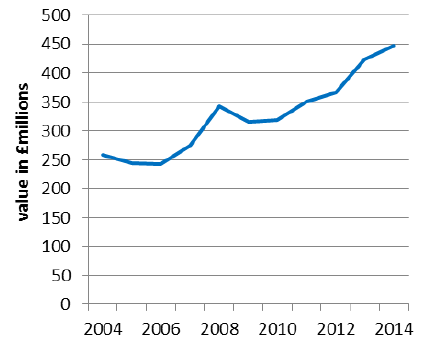
The average price of milk reached 31.5p per litre in 2014, up slightly from 31.3p per litre (0.7 per cent) in 2013, and compared with 18.5p per litre (70 per cent) in 2004. The monthly average price peaked at 33.9p per litre in November 2013, staying at around 33p until May 2014, following which the price fell sharply, ending the year at 27.6p per litre.
In 2014 over half of the milk processed in Scotland was used directly as liquid milk for human consumption, with more semi-skimmed and skimmed than whole or standardised milk. Cheese production was the next largest use. Other uses included butter, cream, yoghurt, milk powders, condensed milk, and chocolate crumb.
Annex B of this publication looks at some historical papers on milk production from 1951.
5.2.6 Specialist dairy FBI (Table B1, B4)
Accounting for inflation, between 2009-10 and 2013-14 the average FBI of dairy farms decreased by around six per cent. This was due to an increase in the input costs for livestock and machinery, land and buildings.
In 2013-14 output values for dairy farms (up £67,000 on the previous year) increased by twice as much as the rise in input costs (up £35,000), resulting in an overall increase in income, almost back to levels last seen in 2010-11. Additionally, the average value of grants and subsidies has increased (up £2,000) to leave the FBI value of dairy farms at £80,000. The total average outputs, (including income from diversification and grants and subsidies) and inputs for dairy farms were £516,000 and £436,000 respectively. The largest portion of the input costs was due to livestock costs such as feed and other inputs such as machinery, land and buildings.
Table B4 compares input and output performance across FBI quartiles for 2013-14 and reveals noticeable differences in key characteristics. Upper quartile (high performing) dairy farms had an average herd size of 240 cows with a yield per cow of 7,549 litres, which sold at 32.31p per litre. Lower quartile farms averaged 150 cows producing 6,017 litres, selling at 30.75p per litre. This results in an average lower quartile FBI of -£6,000 and upper quartile FBI of £205,000.
Over the last five years, FBI without subsidies has been kept above zero. It ranges from £4,000 in 2012-13 to £41,000 in 2011-12. In 2013-14 the average FBI without subsidies of dairy farms was £36,000.
The average FBI/FTE for dairy farms of £39,000 is roughly equivalent to an hourly wage for unpaid labour of £20.45, almost equivalent to three times the minimum agricultural wage in Scotland. Approximately 60 per cent of farms generated an FBI/FTE equivalent to at least twice the minimum agricultural wage per hour of unpaid labour. At the top end, 18 per cent generated between five and ten times the minimum agricultural wage, that is, between £33.40 and £68.90 per hour of unpaid labour and four per cent generated more. In contrast, around a quarter of dairy farms (24 per cent) generated incomes equivalent to less than the minimum agricultural wage.
Cost centre analysis for dairy farms show an overall increase in income as agricultural activities, contracting and subsidies increased compared to 2012-13, income decreased for environmental activities and diversification.
Dairy Farms
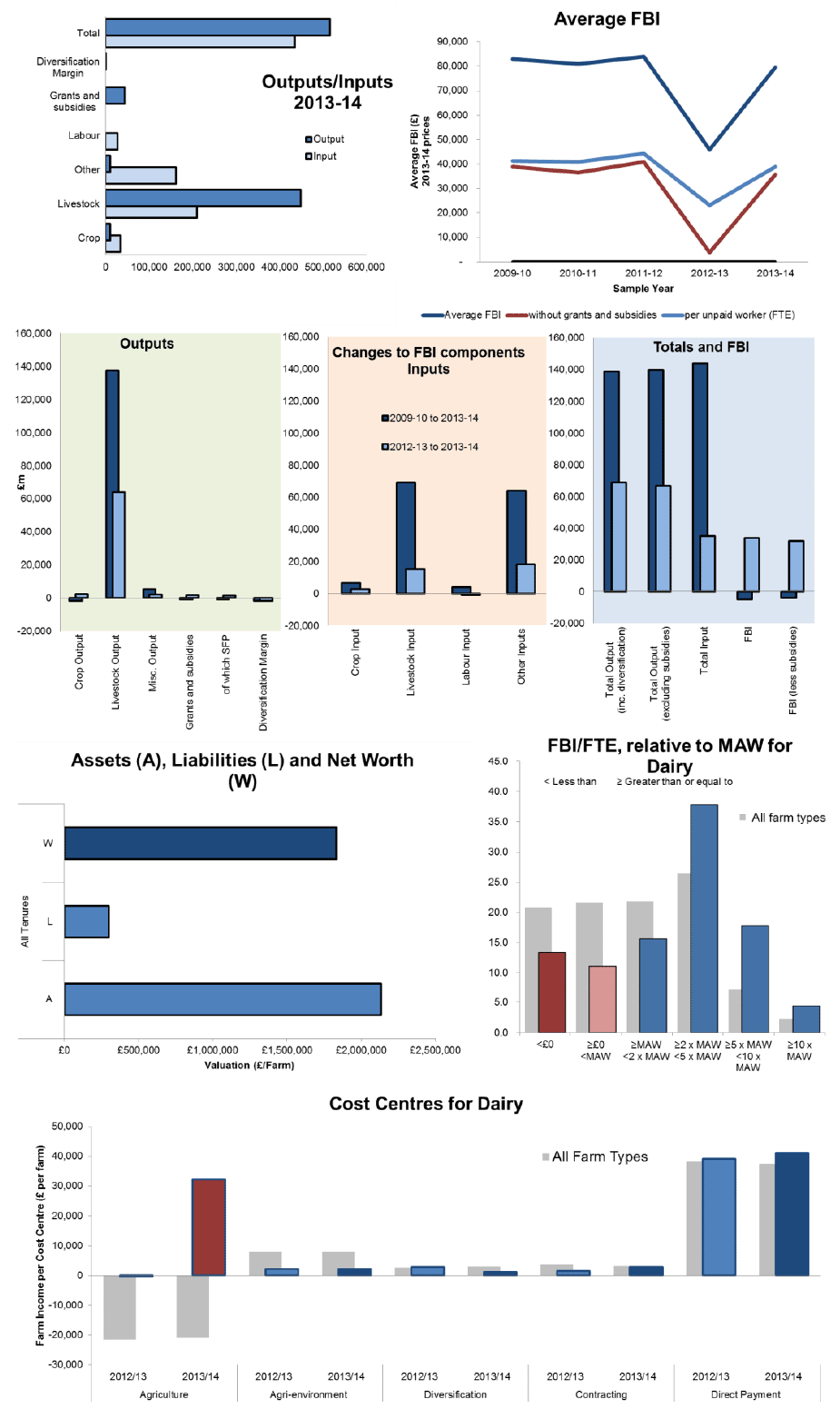
The average net worth (assets minus liabilities) of dairy farms was £1.8m in 2013-14. The average debt ratio (liabilities: assets) was 14 per cent for all tenures of dairy farms.
5.2.7 Dairy and beef enterprises (Table B12)
Overall average gross margins for dairy and beef enterprises ranged from £187 per head for beef finishing enterprises to £396 per head for mixed dairy and beef enterprises, with the exception of dairy cow enterprises at £1,108 per head (equivalent to 15.4 pence per litre).
Where sample sizes were sufficient to allow comparisons between high and low performers, we can see that low performing dairy and beef enterprises generated considerably lower margins. Some low performing beef enterprises generated losses with dairy followers, mixed and finishing enterprises making an average loss, ranging from ‑£4 per head for mixed beef enterprises to -£68 per head for beef finishing. By comparison, high performers in these enterprises achieved gross margins between £407 per head and £692 per head.
High performing dairy cow enterprises made around twice the average gross margin compared to low performers, at £1,538 per head. At £497 per head, high performing lowland suckler herds made around 12 times the margin of low performing enterprises.
On dairy and beef enterprises the difference in financial performance was due to high performers achieving; higher sales prices per head (which is expected to reflect generally higher quality outputs), a greater increase in value due to improved technical performance, and better management of variable costs.
Dairy followers was the only enterprise group to see a fall in margins compared to the previous year. Overall the dairy follower average gross margin per head decreased by 32 per cent compared to 2012-13. Although sales prices increased by 13 per cent to £1,298 per head, higher variable costs (up 25 per cent to £815 per head) and a relatively poor increase from opening and closing valuations (at £85 per head) lead to a lower margin than in 2012-13.
Upland suckler herds (less than six months), mixed beef enterprises and beef forward stores saw the largest increases in margins over the year (up 65 per cent, 54 per cent and 46 per cent respectively). Compared to 2012-13 the average margin for upland sucker herds (less than six months) increased. Despite a fall in sales prices (down 18 per cent) and a rise in variable costs (up three per cent) the value gained through technical performance (closing valuation minus opening valuation) increased to £133 in 2013-14, driving the increase in gross margin. Increased margins were also driven by technical performance in beef forward stores, where the average increase in value of cattle was £140. Again, this was despite a fall in sales price (down one per cent) and a rise in variable costs (16 per cent). While variable costs also increased for mixed beef enterprises (up three per cent) an 18 per cent increase in sales prices caused an overall increase in average gross margin, also outweighing a decline in value of cattle, which fell by £61 between the opening valuation and closing valuation.
Taking account of the size of enterprises, dairy cow (£192,000), mixed dairy enterprises (£46,000) and dairy followers (£29,000) achieved the highest overall enterprise income. Beef forward stores (£10,000) and beef hill herds (£10,000) achieved the lowest. In contrast to gross margin results, the group average output: input ratios, the return achieved per £1 spent, ranged from 1.4 for dairy followers, beef hill herds and finishing enterprises, to 2.0 for dairy cow enterprises.
More detailed results, including sample size information, are available from the agriculture statistics web page, Enterprise Performance Analysis[12].
Dairy and Beef: Enterprise Gross Margin Measures
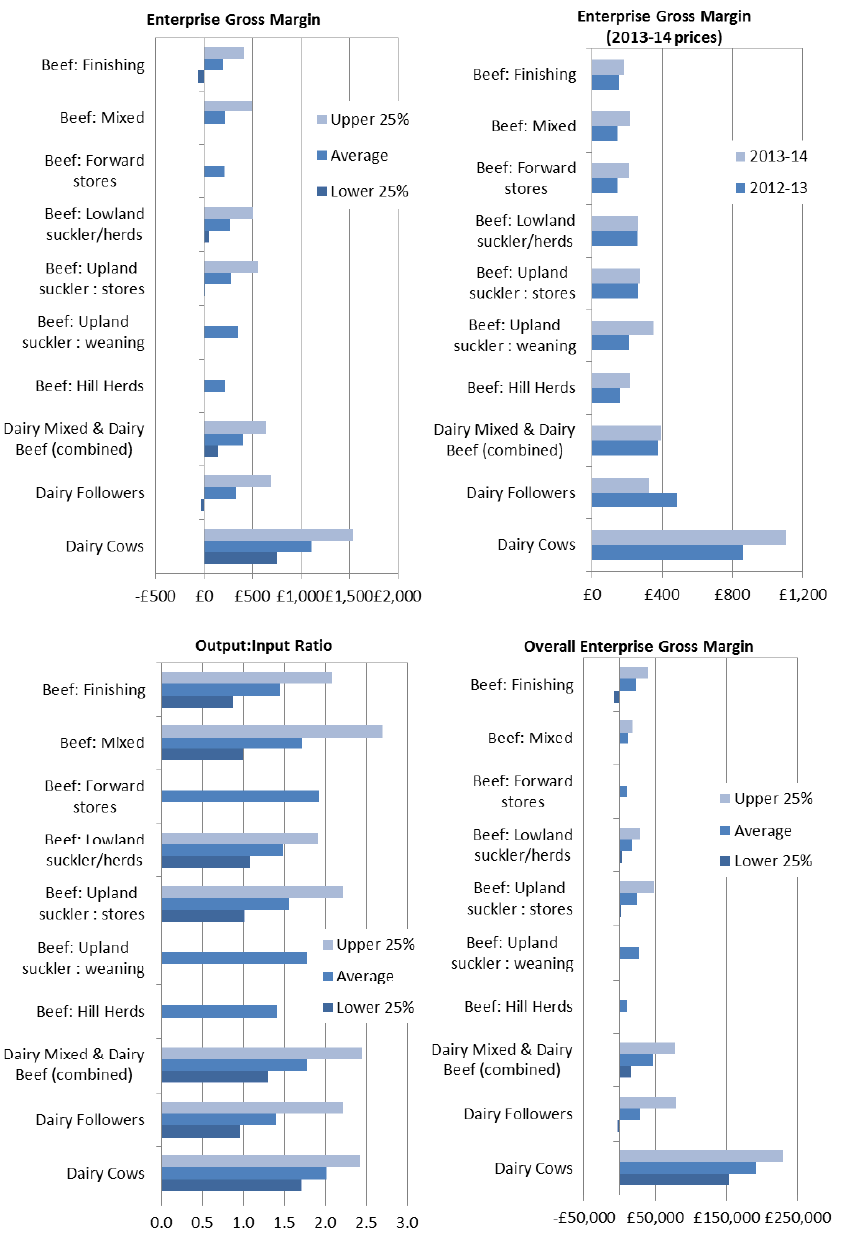
Contact
Email: Agricultural Statistics
There is a problem
Thanks for your feedback
